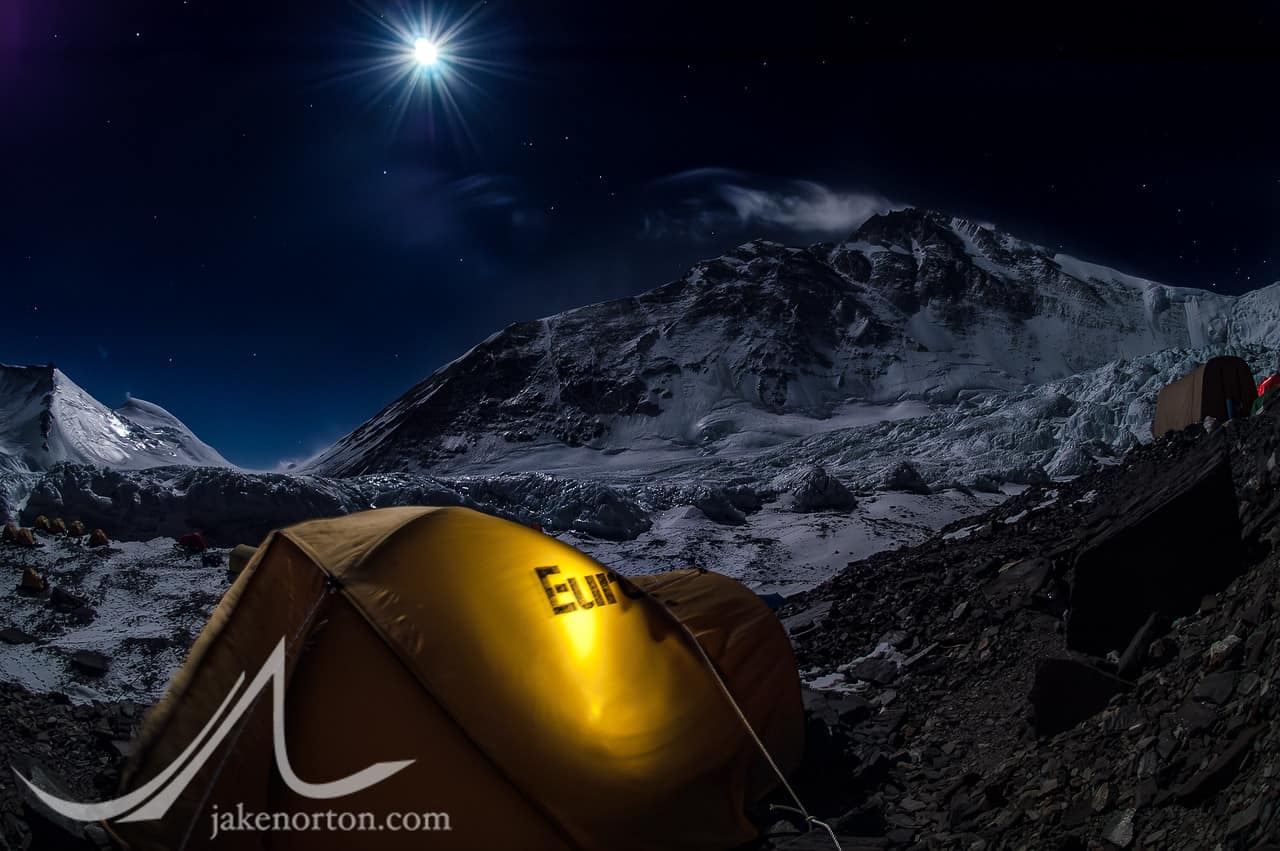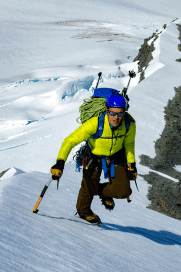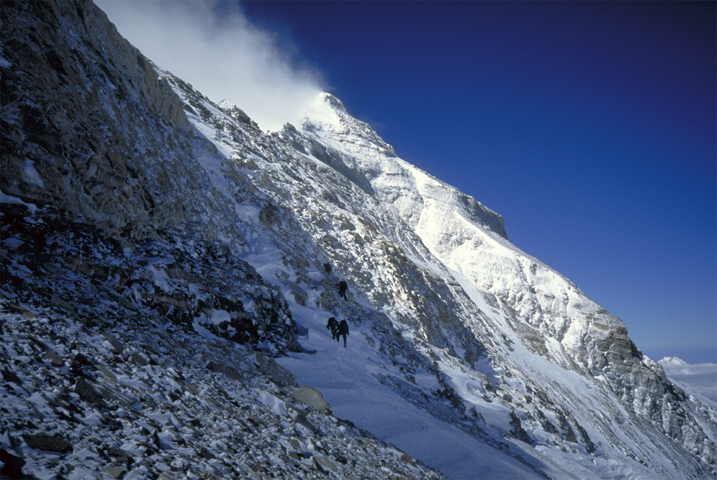It was a great couple days on Mount Everest.

Twenty years ago, the mountain was a lot different than it is today. Absent were the crowds and massive commercial expeditions, especially on the Tibetan side of the peak. Russell Brice and Dan Mazur had big expeditions, but the rest were fairly humble affairs with but a handful of climbers. Daniele Nardi climbed solo up the North Face/Great Couloir, while a powerful Russian-Ukranian (tragic irony) team forced a new route up the North Face’s Central Pillar.
For Dave Hahn and I, the relative solitude was a blessing. Not only did it offer a quieter, simpler experience on the mountain, but we’d also be able to break off the climbing route high on the mountain to do some extra-curricular exploration.

We were there in 2004 to follow up on an account from Chinese climber Xu Jing who, in 2001, said that in 1960 he found a body high on the mountain. Xu had been descending from the Chinese Camp VII high on the Northeast Ridge, and made his sighting in the Yellow Band. With no other known corpses that high on the mountain at that time, if Xu indeed saw a body, it had to be that of Andrew Irvine. Having been a part of the 1999 and 2001 Mallory & Irvine Research Expeditions, Dave and I were well-steeped in the story of 1924 and were back once more to try to put together more pieces of the puzzle.
As a small team - just Dave and I on the hill, assisted up to Camp VI by our friends and climbing Sherpa Danuru and Tashi - we could be pretty nimble on the mountain, moving when it worked best for us, dancing around the machinations of other teams more fixated on the summit. Per usual, the weather dealt us some blows in 2004, disrupting our acclimatization and slowing some progress.

But, by May 17, we had one round of acclimatization under our belts with a night at Camp VI, and were back up for another round. The goal was, admittedly, a bit hazy: our hope, based on the information we had, was to explore some of the Yellow Band from a fall line between the First Step and the Warts (AKA, Twin Towers) on the Northeast Ridge. In theory, this would get us into terrain likely traversed by Xu Jing in 1960 as he descended the mountain and made his sighting.
The challenge, of course, was this was (and remains) pretty uncharted terrain, and not super receptive to unprotected exploration. Dave, being the older and wiser of our duo, didn’t love wandering about small ledge systems on downsloping, fractured limestone with 10,000 feet of exposure below. Being younger and dumber, I was less bothered by the implications of it all, and thus spent much of May 18 poking about, traversing one ledge system to another far off in the Yellow Band, looking, hoping, yearning to find something, to see something, to discover some bit or piece of evidence from June 8, 1924.

Alas, the mountain - and the mystery - had different plans. Despite a lot of walking, scrambling, crawling, panting, staring, looking, pondering, and repeating, Dave and I found nothing. No sign of climbers from 80 years prior, no Andrew Irvine tucked, tragically, in a rocky dihedral (as one translation of Xu Jing’s account attested), no information, no answers.

Of course, that’s not to say it was a waste. Far from it. We covered ground, old and new; we found “new” camps (1960 Chinese Camp VIIa and 1938 Camp VI); we made it home in one piece. And, we had freedom on the mountain: the opportunity to move freely high on Mount Everest - to climb and explore outside the confines of a route or summit plan, with no rope or protection aside from my own (hopeful) skill and sense - was pure bliss, a rare experience anymore on Everest. I could move as a climber, picking the logical path to a logical goal, adjusting course as terrain and ability and conditions allowed or dictated, rather than simply clipping a fixed line and following footsteps.
I was, without doubt, in my happy place, a place of exploration and newness, a small brush with, in George Mallory’s words, “the spirit of adventure [that keeps] alive the soul of man.”




Sounds like pure bliss with two great guys.
Oh the tragic irony of 🇷🇺 🇺🇦 in retrospect.
Great read, Jake! Thank you.
Thanks, Jeanne! And, yes, tragic irony indeed. Thanks again, and be well!
Hello Jake, just wondering what your thoughts are on the Jamie McGuiness video with Thom and his comments about the Chinese removing Sandy Irvine's body. Thanks for all you do.
Hi Robert,
Thanks for your note! I just watched Thom's interview with Jamie last night. While interesting, I personally didn't see anything revelatory or new per se in the interview. It seems to me - spoiler - that the anonymous Sherpa is most likely Chhiring Dorje, who in 1995 was climbing in support of the Japanese 1995 expedition on the Northeast Ridge Direct. Chhiring talked about his find quite a bit in the early days, but then went quiet about it all, likely/possibly because of pressure from or fear of the Chinese authorities. But, from what I know, Chhiring was climbing from below the Third Pinnacle up into the Yellow Band - likely along the Longland Traverse somewhere - when he made his find. Below is a cool shot of entering the Longland from the '95 expedition:

As for the Chinese removing Irvine's body, I think we sadly still don't know for sure what happened. It's a lot of whispers and stories from third parties, but nothing concrete. I think there is a good chance that the Chinese did "clean" Irvine off the mountain, and my guess is that it happened in 2008 when they made a big effort to sanitize the mountain for their torch climb. What they did with his remains (assuming they found him) is sadly a mystery, and one we may never know the answer to.
I wish I had more concrete info on it all. Here's to hoping someday sooner than later the Chinese will understand that there is nothing to lose by helping tell the full and complete story of 1924.
Thanks, Robert, and I hope you're well!
C'est passionnant !
Merci beaucoups Pierre!
The Japanese 95 expeditiom has some truly stunning pictures.
https://www.everest.co.jp/everest95/nu-ev95-e.html
One in particular shows 1 - possibly 2 - red features on the 2nd pinnale - wonder if that is Boardman and Tasker - do we know?
https://www.everest.co.jp/everest95/nu-ev95-e.html (Picture 10, just a bit below and to the right of the center of the image).
Regarding Irvine - looking at all these obvious places on the prominent ledges in the YB and the searches, it would seem rather unlikely that Irvine is still there, since it was spotted in 1960 and 1995 and they weren't even looking.
Thanks for your comment, Oliver, and I agree - some amazing photos from that expedition! I wish I knew how to get some high res versions.
And, good eyes: it does seem to show something, hard to tell what precisely, in the photo of the Second Pinnacle here: https://www.everest.co.jp/everest95/ev044.jpg Would love to dig deeper into it. I'm heading home now from Tanzania, but will try to get to this once home and can do some more research.
As for Irvine, I think you make a good point that the '60 and '95 sightings were done by chance, so it seems if Irvine was still there AND someone went through the same area, he should be easy to see.
Thanks for your answer, very interesting. By the way, I have just started to check out your own galleries. Amazing shots, particularly from 2019! Which brings me to my next question:
would you happen to know how to watch your 2019 documentary? I am based in Norway and find it quite difficult to find a streaming service for it.
Thanks!
Thanks, Oliver! On the 2019 film, it is hard to find overseas. I'll email you a solution at the address you provided - hopefully that is a good one!
One sighting of Irving I’ve seen referenced several times is that of Chhiring Dorje on the 1995 Nihon University ascent of the full north ridge. However, I came across an interview with Chhiring Dorje in a local Colorado newspaper that implies he thinks the body he saw was actually that of Mallory. Not sure if the descriptions, elevations and locations all align, but I haven’t found a more detailed description of his sighting.
https://www.steamboatpilot.com/explore-steamboat/elite-sherpa-sardar-with-local-ties-looks-to-solve-summit-mystery/
Hi Bill,
Thanks for the note and comment. I've read that article before, and it seems to me maybe the author lost some things in translation. The 1995 expedition put their high camp below the Pinnacles, not far from where I relocated the 1938 Camp VI in 2004. I found their tent poles and some other bits and bobs at that time. So, it seems to me Chhiring Dorje would have been going from that camp and up higher, most likely following some version of the Longland Traverse, when he made his sighting. Everything I've read in the past has indicated this, but who knows for sure. As for him finding Mallory, that seems unlikely to me simply because Mallory's body was not in a location conducive to finding if one was moving in a specific direction, as Chhiring was. Wang likely found Mallory in 1975 because he was just wandering, not moving from camp to camp. Conrad found GLM in 1999 because we were in the area with that specific mission. But, you'd never end up over there in my mind if you were working on an expedition with an objective, like Chhiring was in 1995.
So, my hunch has been and is that if he indeed saw an old body, it must have been Irvine, and must have been somewhere up in the mid-Yellow Band. That said, that's just my thought, and not gospel by any stretch!
Thanks, and all best,
Jake